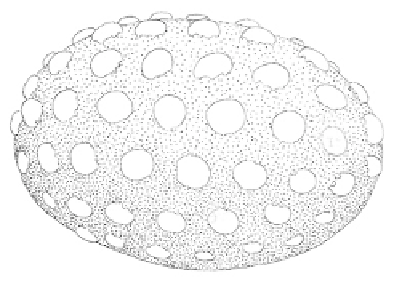Agriculture Reference
In-Depth Information
Fig. 339
Hindleg of male broad mite,
Polyphagotarsonemus latus.
Fig. 341
Larva of broad mite,
Polyphagotarsonemus
latus
(x400).
torted; they are also frequently bright green,
lacking the greyish bloom of healthy tissue. Fur-
thermore, leaves may become scarred and may
develop yellow streaks and characteristic saw-
tooth edges (see also damage caused by bulb
mites,
Rhizoglyphus
spp., p. 269). Infestations
have an adverse effect on flower production. On
some host plants, such as amaryllis, the mites
induce the formation of reddish spots or streaks
on the emerging leaves.
Fig. 340
Egg of broad mite,
Polyphagotarsonemus
latus
(x550).
BIOLOGY
Mites invade host bulbs in August and Septem-
ber, when they gain access to the spaces created
by the shrinking scales. They then begin to feed,
especially in the neck region, and breeding colo-
nies soon develop. The mites breed continuously
under favourable conditions, passing through an
egg, a larval and a quiescent nymphal stage. De-
velopment to adulthood usually takes several
weeks but becomes more rapid at bulb-forcing
temperatures. Mites will continue to breed on
infested bulbs planted in the field but, again, the
rate of development (and, hence, colony growth)
depends on temperature, usually becoming
greatly protracted during the autumn and winter
Steneotarsonemus laticeps
(Halbert)
Bulb scale mite
Bulb scale mite is an important pest of forced
narcissus; it is also associated with certain other
members of the Amaryllidaceae, including ama-
ryllis and eucharis. Stored infested bulbs dry out
and, if cut across, show evidence of dead, dark
brown tissue between the scales; such symptoms
are particularly noticeable in the upper part of
the neck. Heavy infestations in stored bulbs may
be responsible for considerable losses. Leaves
emerging from mite-infested narcissus bulbs are
weak and often sickle-shaped or otherwise dis-



